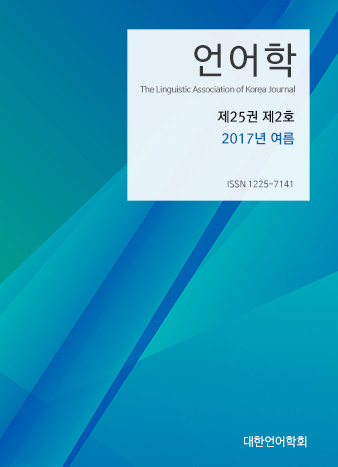대한언어학회 전자저널
25권 2호 (2017년 6월)
- DP/PP asymmetry in English infinitival relative clauses
-
김양순
Pages : 61-84
Abstract
Kim, Yangsoon. (2017). DP/PP asymmetry in English infinitival relative clauses. The Linguistic Association of Korea Journal, 25(2), 61-84. The purpose of this paper is to present the proper syntactic structures and analyses for finite and infinitival relative clauses and explain why there is a DP/PP asymmetry only in infinitival relative clauses in terms of preposition stranding and pied-piping of a wh-relative phrase and a preposition. In the infinitival relative clauses, the pied-piping of a preposition and a wh-relative pronoun is possible but preposition stranding is not possible. I propose the separate and different analyses for finite and infinitival relative clauses: the determiner complement hypothesis or the CP-adjunction hypothesis for finite relative clauses vs. the PP-adjunction hypothesis for infinitival relative clauses. The contrast in the DP/PP asymmetry relates specifically to the finite/non-finite structural distinction of relative clauses. In the proposed analysis of PP-adjunction to NP(N') with an obligatory head P-raising and a subsequent DP-raising for infinitival relative clauses, the DP/PP asymmetry can be easily and explicitly explained in a minimalist way.
Keywords
# DP/PP asymmetry # infinitival relative clauses # PP-adjuncts # P-head raising # DP-raising
References
- Bianchi, V. (2000). Some issues in the syntax of relative determiners. In A. Alexiadou, A. Meinunger, & C. Wilder (Eds.), The syntax of relative clauses, (pp. 161-199). Amsterdam: John Benjamins Publishing Company.
- Browing, M. (1991). Null operator constructions. New York: Garland.
- Carnie, A. (2013). Syntax: a generative introduction, 3rd edition. New Jersey: Wiley-Blackwell.
- Chomsky, N. (1977). On Wh-movement. In P. Culicover, T. Wasow, & A. Akmajian (Eds.), Formal syntax (pp. 71-132). New York: Academic Press.
- Chomsky, N. (1981). Lectures on government and binding. Dordrecht: Foris.
- Chomsky, N. (1982). Some concepts and consequences of the theory of government and binding. Cambridge, Mass.: MIT Press.
- Chomsky, N. (1995). The minimalist program. Cambridge, MA: MIT Press.
- Chomsky, N. (2005). On phase. Unpublished manuscript, MIT.
- Chomsky, N., & Lasnik, H. (1977). Filters and control. Linguistic Inquiry, 8, 425-504.
- Cowan, R. (2013). The teacher's grammar of English. Cambridge: Cambridge University Press.
- Emonds, J. (1976). A transformational approach to English syntax. New York: Academic Press.
- Grosu, A. (1996). The proper analysis of “missing-P” free relative constructions: a reply to Larson. Linguistic Inquiry, 27, 257-293.
- Hornstein, N., & Weinberg, A. (1981). Case theory and preposition stranding. Linguistic Inquiry, 12, 55-91.
- Jarad, N. I. (1997). The origin and development of for-infinitives. Doctoral dissertation, University of Wales, Bangor.
- Kayne, R. (1994). The antisymmetry of syntax. Cambridge, Mass.: MIT Press.
- Kim, Y.-S. (2007). Infinitives and EPP. The Journal of Studies in Language, 2(3). 1-28.
- Kuroda, S.-Y. (1988). Whether we agree or not: A comparative syntax of English and Japanese. Linguistic Investigations, 12, 1-47.
- Larson, R. (1987). Missing prepositions and the analysis of English free relatives. Linguistic Inquiry, 18, 63-69.
- Law, P. (2000). The DP/PP adjunction asymmetry. In A. Alexiadou, A. Meinunger, & C. Wilder (Eds.), The syntax of relative clauses (pp. 161-199). Amsterdam: John Benjamins Publishing Company.
- Riemsdijk, H. (1978). A case study in syntactic markedness. Lisse: The Peter de Ridder Press.
- Safir, K. (1986). Relative clauses in a theory of binding and levels. Linguistic Inquiry, 17, 663-689.
- Schmitt, C. (2000). Some consequences of the complement analysis for relative clauses, demonstratives and the wrong adjectives. In A. Alexiadou, A. Meinunger, & C. Wilder (Eds.), The syntax of relative clauses (pp. 309-348). Amsterdam: John Benjamins Publishing Company.
- Van linden, A. (2010). The rise of the to-infinitive: Evidence from adjectival complementation. English Language and Linguistics, 4(1), 19-51.
- Vergnaud, J.-R. (1974). French relative clauses. Doctoral dissertation, MIT.
- Williams, E. (1983). Syntactic vs. semantic categories. Linguistics & Philosophy, 6, 423-446.
